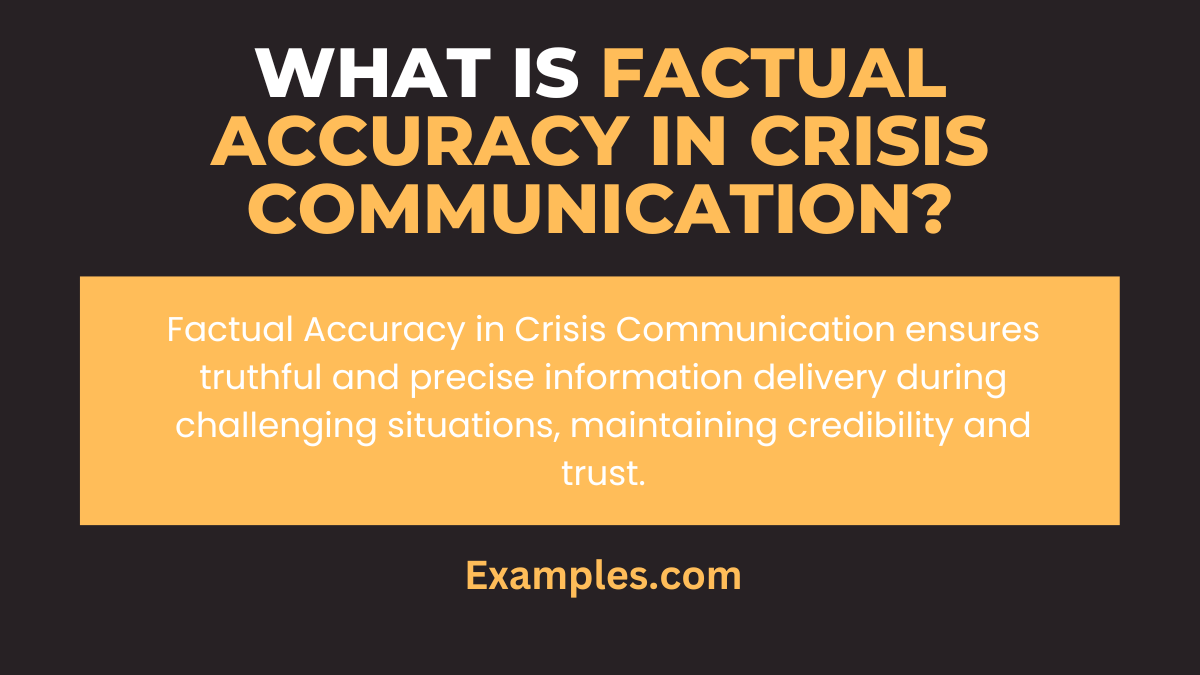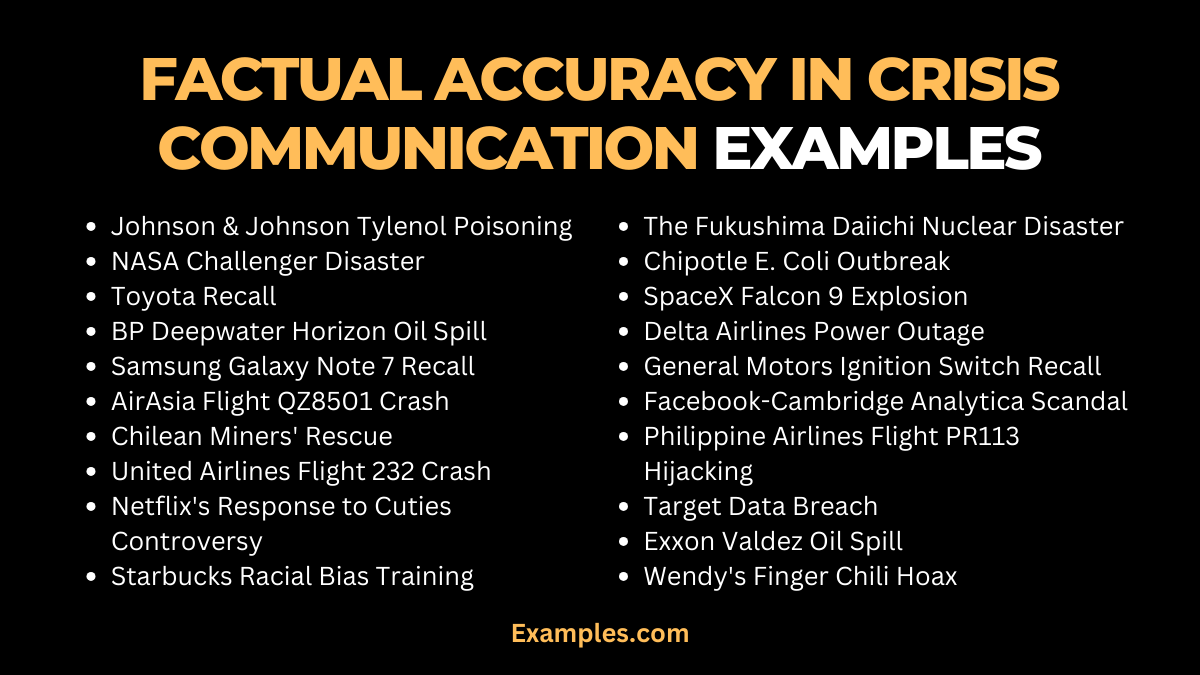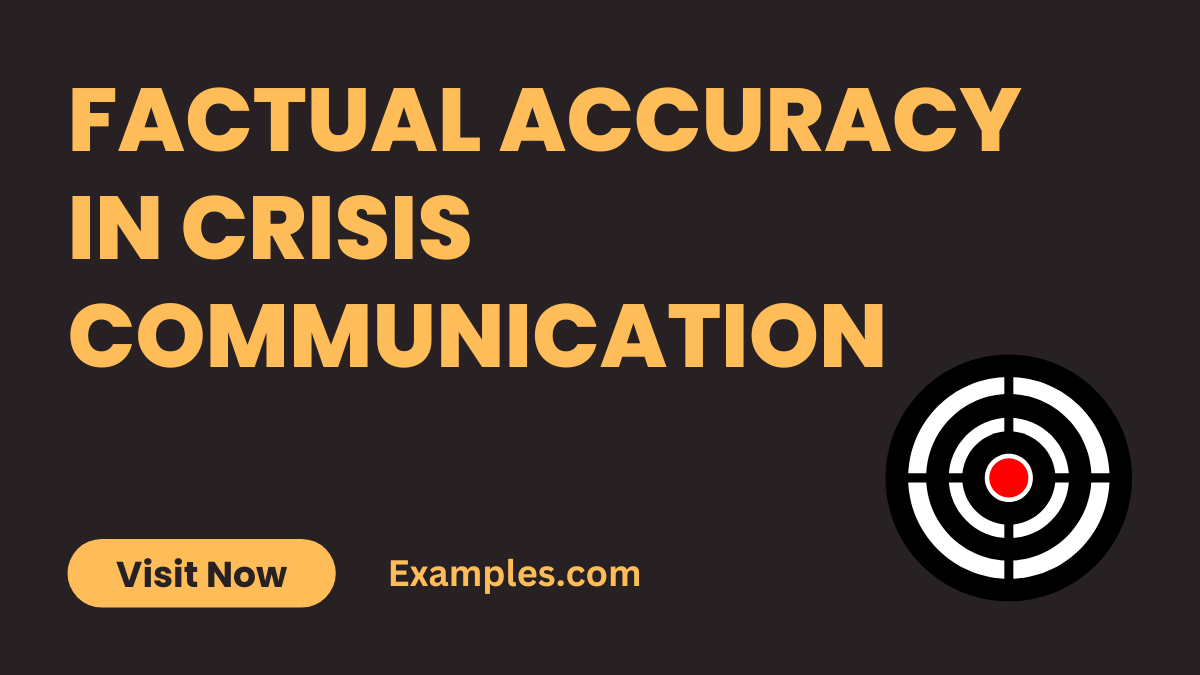19+ Factual Accuracy in Crisis Communication Examples
Dive into the definitive guide on Factual Accuracy in Crisis Communication! Unearth the nuances of effective crisis management with real-world Communication Examples. This comprehensive resource empowers you with the knowledge and examples to master the delicate balance of accuracy during challenging situations. Elevate your crisis communication strategy with insights, tips, and tangible examples that ensure your messaging remains precise and reliable when it matters most. Discover the power of factual accuracy to navigate crises seamlessly!
What is Factual Accuracy in Crisis Communication?

Factual Accuracy in Crisis Communication refers to the unwavering commitment to conveying information that is precise, truthful, and reliable during challenging situations. It involves ensuring that the details provided are accurate, minimizing the risk of misinformation. In times of crisis, maintaining factual accuracy is crucial for building trust and credibility. This approach ensures that the information shared is dependable, fostering a transparent and reliable communication process amid uncertainty.
What is the Best Example of Factual Accuracy in Crisis Communication?

One outstanding example of Factual Accuracy in Crisis Communication is the response to the Tylenol poisoning crisis in 1982. When cyanide-laced capsules led to multiple deaths, Johnson & Johnson took immediate action. The company prioritized transparency, recalling 31 million bottles, and openly communicated the issue. Their forthrightness and rapid, accurate information dissemination protected public safety and showcased the pivotal role of factual accuracy in crisis communication, earning them commendation for responsible and effective crisis management.
20 Factual Accuracy in Crisis Communication Examples

Explore 20 exemplary instances of Factual Accuracy in Crisis Communication, a vital aspect of effective crisis management. This curated collection showcases diverse scenarios where precision and truthfulness played a pivotal role in navigating challenges seamlessly. Each example provides valuable insights for honing your crisis communication skills and ensuring accurate information dissemination in critical situations.
- Johnson & Johnson Tylenol Poisoning (1982): Boldly recalled 31 million bottles, prioritizing transparency, and protecting public safety through accurate communication.
- NASA Challenger Disaster (1986): Despite tragedy, NASA maintained factual accuracy, transparently addressing the crisis and emphasizing safety improvements.
- Toyota Recall (2010): Acknowledged defects promptly, emphasizing factual accuracy, and rebuilding trust through open communication and corrective actions.
- BP Deepwater Horizon Oil Spill (2010): Faced with a major crisis, BP worked diligently to provide accurate information, accepting responsibility and committing to resolution.
- Samsung Galaxy Note 7 Recall (2016): Responded decisively to battery issues, prioritizing consumer safety and maintaining factual accuracy in communications.
- AirAsia Flight QZ8501 Crash (2014): AirAsia displayed transparency, keeping families informed with accurate details and demonstrating a commitment to accountability.
- Chilean Miners’ Rescue (2010): Aided by factual communication, the successful rescue operation exemplified transparency and precision throughout the crisis.
- United Airlines Flight 232 Crash (1989): Despite tragedy, United Airlines maintained open communication, prioritizing accurate information to manage the crisis effectively.
- Netflix’s Response to Cuties Controversy (2020): Addressed concerns through factual communication, emphasizing artistic intent and commitment to responsible content.
- Starbucks Racial Bias Training (2018): Responded to an incident with factual accuracy, showcasing commitment to addressing racial bias through comprehensive employee training.
- The Fukushima Daiichi Nuclear Disaster (2011): Japan’s government communicated facts transparently, prioritizing public safety in the face of a severe crisis.
- Chipotle E. Coli Outbreak (2015): Managed the crisis by swiftly communicating accurate information, addressing the issue, and implementing preventative measures.
- SpaceX Falcon 9 Explosion (2016): Maintained factual accuracy, openly sharing information on the incident, and highlighting improvements for future launches.
- Delta Airlines Power Outage (2016): Communicated transparently, providing accurate updates and resolutions during a critical operational crisis.
- General Motors Ignition Switch Recall (2014): Acknowledged faults, emphasizing factual accuracy, and implementing measures to address safety concerns.
- Facebook-Cambridge Analytica Scandal (2018): Facebook responded transparently, addressing data privacy concerns and committing to enhanced user protection.
- Philippine Airlines Flight PR113 Hijacking (1994): Demonstrated factual accuracy in crisis communication, ensuring passengers’ safety through precise information dissemination.
- Target Data Breach (2013): Communicated openly about the breach, prioritizing factual accuracy, and implementing security measures for customer protection.
- Exxon Valdez Oil Spill (1989): Despite the magnitude, Exxon prioritized factual accuracy, communicated transparently, and took responsibility for the environmental crisis.
- Wendy’s Finger Chili Hoax (2005): Handled the false claim with factual accuracy, using communication to dispel rumors and maintain brand integrity.
Factual Accuracy in Crisis Communication Examples for Students
Explore real-world instances illustrating Factual Accuracy in Crisis Communication tailored for students. Discover how precision and truthfulness play a crucial role in effectively managing crises, offering valuable insights for academic scenarios.
- Campus Security Threat (2019): In response to a potential security threat, the university swiftly communicated factual details to students, ensuring clarity and safety.
- Online Learning Glitch (2020): A university addressed technical issues transparently, providing accurate updates to students during a virtual learning crisis.
- Student Health Pandemic Communication (2021): During the COVID-19 pandemic, educational institutions prioritized accurate information, guiding students through health protocols.
- Protest Management (2018): A university navigated a protest by transparently communicating facts, fostering understanding and minimizing potential disruptions.
- Natural Disaster Response (2017): In the face of a natural disaster, a university communicated evacuation plans and safety measures, ensuring students’ well-being with precise information.
Factual Accuracy in Crisis Communication Examples in Business
Delve into instances showcasing Factual Accuracy in Crisis Communication within the business realm. Uncover how organizations uphold truthfulness during crises, offering lessons for maintaining credibility in challenging business scenarios.
- Product Recall (2015): A company recalled a defective product, communicating accurate information to customers and stakeholders, rebuilding trust through transparency.
- Employee Layoffs (2020): In a challenging economic climate, a business communicated layoffs with factual accuracy, minimizing uncertainty and maintaining employee trust.
- Supply Chain Disruption (2016): Amid supply chain challenges, a business communicated effectively, sharing accurate information with partners and customers to manage expectations.
- Financial Scandal Response (2014): Faced with a financial scandal, a company communicated transparently, providing accurate details and outlining corrective measures to regain investor confidence.
- Data Breach Resolution (2018): Responding to a data breach, a business communicated with factual accuracy, informing affected parties promptly and implementing robust cybersecurity measures for future protection.
How to Ensure Factual Accuracy in Crisis Communication?
Maintaining Factual Accuracy in Crisis Communication is paramount for credibility. Follow these steps to ensure precision during challenging situations:
- Swift Information Verification: Verify facts before communication to avoid spreading misinformation.
- Establish Clear Communication Protocols: Define clear channels and roles for disseminating information, ensuring a coordinated and accurate response.
- Create a Crisis Communication Team: Assemble a dedicated team to manage communication, emphasizing the importance of factual accuracy.
- Regular Training Programs: Conduct training sessions for communication teams to enhance their skills in verifying and conveying accurate information.
- Utilize Reliable Sources: Rely on trustworthy sources for information validation to strengthen the accuracy of your communication.
- Implement Technology Safeguards: Leverage technology for real-time fact-checking, ensuring accurate data dissemination.
- Draft Pre-approved Messages: Prepare pre-approved templates for common crisis scenarios, maintaining factual accuracy in response.
- Monitor and Adapt: Continuously monitor unfolding events, adapting communication strategies based on the evolving crisis situation.
What are Factual Accuracy in Crisis Communication Strategies?
Crafting effective strategies for Factual Accuracy in Crisis Communication involves a thoughtful approach:
- Establish a Centralized Information Hub: Create a central repository for accurate information accessible to all communication channels.
- Prioritize Transparency: Embrace transparency, providing stakeholders with honest and accurate details during a crisis.
- Consistent Messaging: Ensure consistency across all communication channels, avoiding conflicting information.
- Tailor Communication to Stakeholders: Customize messages for different stakeholders, addressing their specific concerns with accurate information.
- Engage in Active Listening: Acknowledge feedback and concerns, actively listening to stakeholders to enhance the accuracy of subsequent communications.
- Regular Updates: Provide timely and regular updates, maintaining accuracy while keeping stakeholders informed about developments.
- Scenario Planning: Anticipate potential crisis scenarios, strategizing communication approaches with a focus on accuracy.
- Utilize Multi-Channel Communication: Employ various communication channels for redundancy, ensuring accurate information reaches a broad audience.
What Factors Affect Factual Accuracy in Crisis Communication?
Understanding the factors influencing Factual Accuracy in Crisis Communication is crucial for effective management:
- Information Overload: Excessive data can lead to confusion, affecting the accuracy of communication. Prioritize essential information.
- External Pressures: External influences, such as public opinion or media pressure, can impact the accuracy of crisis communication.
- Human Error: Mistakes in information gathering or dissemination can compromise accuracy. Implement thorough review processes.
- Crisis Severity: The severity of the crisis can influence the accuracy of communication. High-stakes situations may require more meticulous fact-checking.
- Lack of Preparedness: Unprepared communication teams may struggle to ensure accuracy. Adequate training and preparation are crucial.
- Rapid Decision-Making: Urgent decisions may lead to hasty communication. Establish protocols to balance speed with accuracy.
- Emotional Impact: Emotional situations can cloud judgment. Train communication teams to navigate emotions while maintaining factual accuracy.
- Technology Glitches: Technical issues can disrupt communication. Have contingency plans to address technology-related challenges swiftly.
In conclusion, mastering Factual Accuracy in Crisis Communication is paramount for credibility. This comprehensive guide has explored strategies, examples, and essential steps to navigate challenges seamlessly. By learning from real-world instances and adopting proactive measures, communicators can ensure accuracy, build trust, and effectively manage crises. Elevate your crisis communication skills with this insightful and practical resource.



